Picture Sarah’s Portland backyard last February, where her newly planted Oregon grape shrubs actually seemed to perk up during the week-long downpour that left her neighbor’s non-native landscaping looking waterlogged and miserable. You’ve probably noticed how some plants thrive while others struggle during Western Oregon’s infamous wet months, but choosing the right rain-loving natives can transform your garden from a soggy mess into a thriving ecosystem that works with nature’s rhythm instead of against it.
Contents
- 1 Western Oregon’s Wet Season Gardening
- 2 Rain-Adapted Wildflowers for Gardens
- 3 Rain-Loving Canopy Trees
- 4 Rain-Tolerant Understory Shrubs
- 5 Selecting the Right Native Plants for Your Garden
- 6 Frequently Asked Questions
- 6.1 When Is the Best Time to Plant Rain-Loving Natives in Western Oregon?
- 6.2 How Do I Prepare Soil Drainage for Rain-Loving Native Plants?
- 6.3 What Are Common Pests That Affect Rain-Loving Natives in This Region?
- 6.4 How Much Maintenance Do Established Rain-Loving Native Plants Require Annually?
- 6.5 Can Rain-Loving Natives Survive Western Oregon’s Occasional Summer Drought Periods?
Western Oregon’s Wet Season Gardening
While Western Oregon’s reputation for endless drizzle might discourage some gardeners, the region’s wet season actually creates perfect conditions for establishing thriving native plant gardens. You’ll find that fall and winter planting lets your natives capitalize on natural rainfall for strong root development. Smart flood management starts with strategic placement of rain gardens and bioswales to capture runoff before it waterlogs your main beds. Essential soil amendments like compost and organic matter improve drainage while boosting absorption capacity. Group plants by moisture needs, and you’ll optimize rain distribution throughout your garden during those soggy months. These rain-loving natives provide essential wildlife habitat for birds, amphibians, and small mammals seeking shelter during the wet season.
Rain-Adapted Wildflowers for Gardens
Western Oregon’s native wildflowers offer gardeners colorful, low-maintenance options perfectly suited to the region’s wet winters and variable rainfall patterns throughout the growing season. These woodland species thrive in the shaded forests characteristic of the moist coastal temperate rainforests west of the Cascades.
Oregon Iris (Iris Tenax)
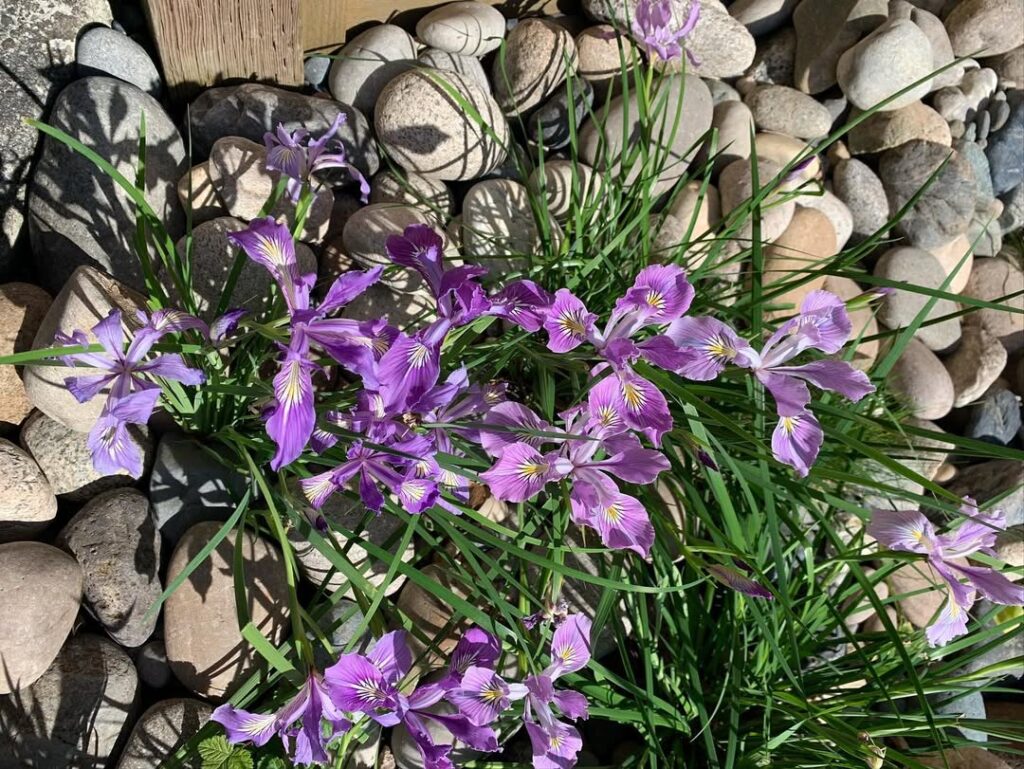
Oregon Iris (Iris tenax) is a stunning native wildflower that brings vibrant color to spring gardens throughout western Oregon. This adaptable perennial produces showy blooms in shades of lavender, deep purple, cream, or yellow from April to June, rising above dense clumps of narrow, grass-like foliage that can reach 14 inches tall.
Perfectly suited for rain gardens and bioswales, Oregon Iris thrives in the region’s wet winter conditions while becoming drought-tolerant once established. Its strong fibrous leaves were historically valued by Native Americans for weaving and cordage. This deer-resistant wildflower supports pollinators including hummingbirds, butterflies, and bees, making it an excellent choice for native landscapes and restoration projects. The plant spreads through rhizomes that expand slowly, creating the appearance of tight bunchgrass when not flowering.
- Hardiness: USDA zones 7-9, native to elevations 300-1600 feet
- Light: Full sun to partial shade
- Water: Medium water needs; rain-adapted, drought-tolerant when established
- Soil: Well-drained to moist soils; adaptable from meadow to forest conditions
- Fertilizer: Not required; adapted to native soil conditions
- Pest/Disease Resistance: Deer resistant, generally pest-free
- Growth Rate: Moderate; forms dense clumps over time
Camas (Camassia Leichtlinii)
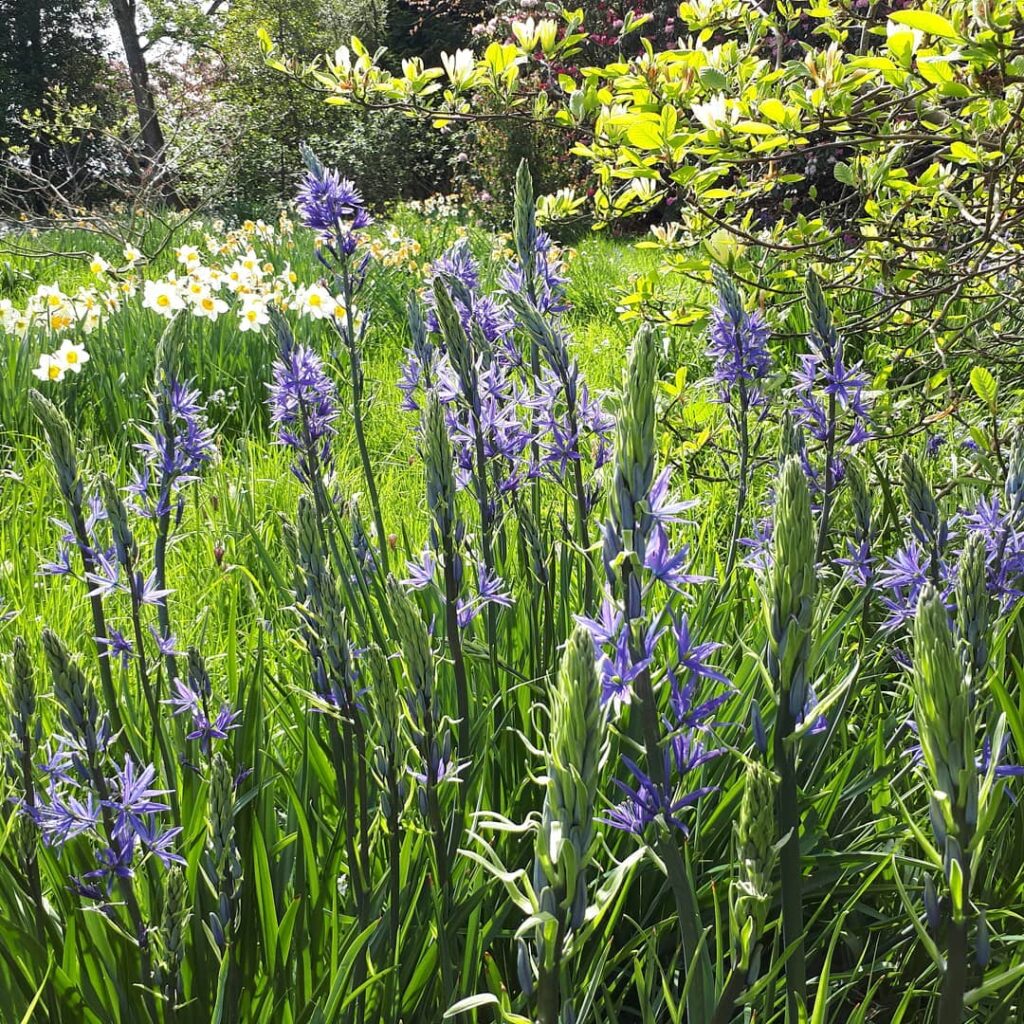
Camas (Camassia leichtlinii) is a spectacular spring-flowering native bulb that produces towering 2.5-4 foot spikes adorned with 20-80 star-shaped flowers in colors ranging from white to deep violet-purple. This Pacific Northwest native thrives in western Oregon’s wet climate, forming dense colonies in moist meadows and mountain slopes. The sturdy stems require no staking despite their impressive height and flower load.
Historically significant as a food source for indigenous peoples, camas bulbs were a dietary staple and the genus name derives from the Native term “quamash.” The plant goes dormant in late summer after blooming, with foliage naturally dying back. The species name honors Max Leichtlin, a German horticulturist who introduced many plants into cultivation. Its reliable flowering, low maintenance requirements, and ability to naturalize make it an excellent choice for rain gardens and wildflower meadows.
- Hardiness: USDA zones 4-8, cold hardy but foliage damaged below 23°F
- Light: Full sun preferred, tolerates up to 25% shade
- Water: Regular moisture through spring growth and bloom, tolerates drier conditions after dormancy
- Soil: Tolerates wet and heavy soils, well-suited for poorly-drained locations
- Fertilizer: Minimal requirements, thrives in natural conditions
- Pest/Disease Resistance: Excellent, no serious insect or disease issues
- Growth Rate: Moderate establishment, reliably blooms for many years once established
Western Bleeding Heart (Dicentra)
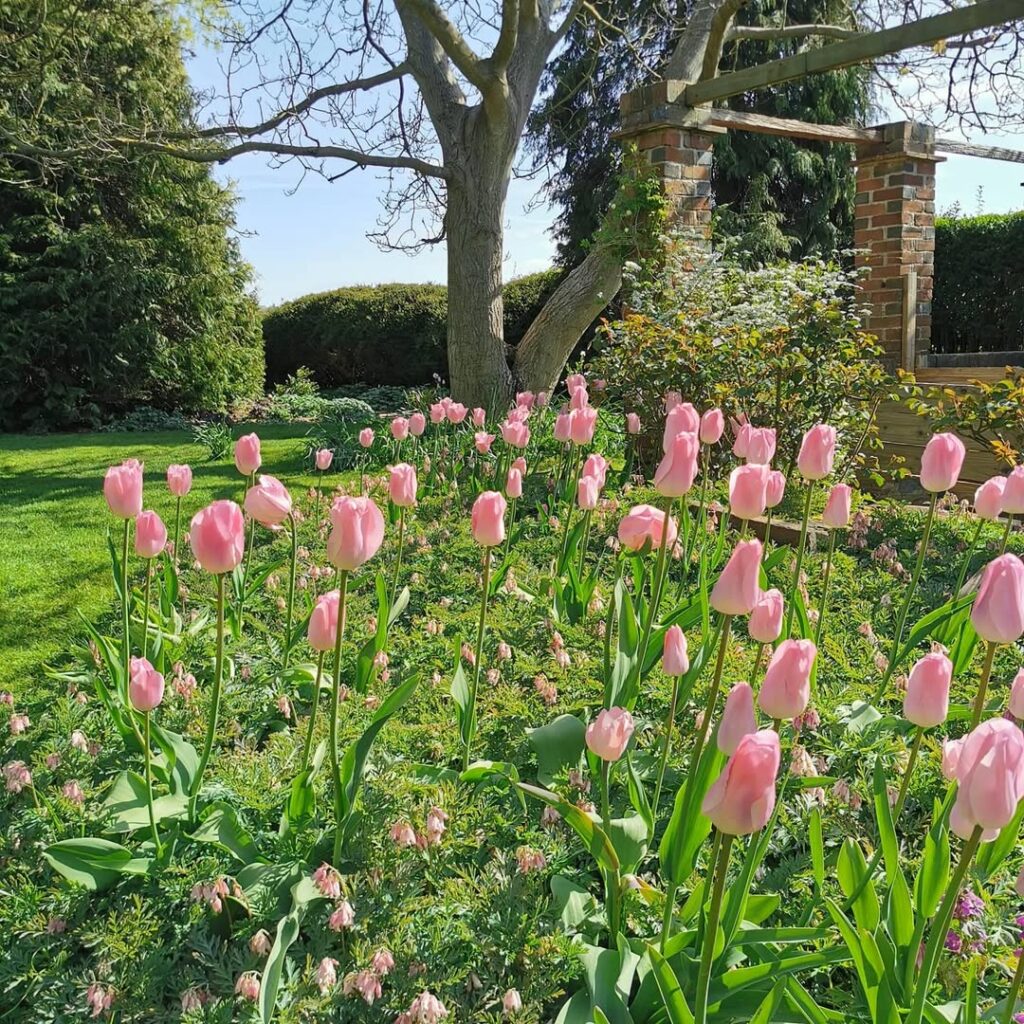
Western Bleeding Heart (Dicentra formosa) is a charming native perennial that thrives in Oregon’s rainy climate. This delicate woodland plant features finely divided, fernlike foliage and distinctive heart-shaped flowers in shades of pink, white, or red that bloom from spring through summer. Rising on slender stems above the bluish-green leaves, the flowers create an enchanting display in shaded garden areas.
Naturally adapted to the moist forests and woodlands west of the Cascades, Western Bleeding Heart forms beautiful ground cover in woodland gardens. The plant goes dormant during hot, dry summers but may rebloom in fall if adequate moisture returns. Its self-seeding nature allows for natural spreading in favorable conditions, making it an excellent choice for naturalizing in rain-loving garden settings. The flowers attract hummingbirds and bumble bees, while providing important habitat for wildlife including larvae of Clodius parnassian butterflies.
- Hardiness: Cold hardy, survives Pacific Northwest winters
- Light: Part shade to full shade, prefers dappled sunlight
- Water: High moisture requirements, not drought tolerant
- Soil: Moist, well-draining soils
- Fertilizer: Low maintenance, minimal fertilizer needs
- Pest/Disease Resistance: Generally resistant to pests and diseases
- Growth Rate: Moderate, self-seeds readily for natural spread
Red Flowering Currant (Ribes)

Red Flowering Currant is a stunning native deciduous shrub that exemplifies rain-adapted gardening in western Oregon. Growing up to 10 feet tall and wide, it produces drooping clusters of tubular flowers in early spring, ranging from white and pale pink to deep red. The maple-like leaves emit a distinctive resinous aroma, while blue-black berries follow the blooms.
This low-maintenance shrub thrives in Oregon’s wet winters and dry summers, requiring minimal irrigation once established. It serves as a vital early nectar source for hummingbirds and butterflies while supporting over two dozen moth and butterfly species as larvae. Multiple cultivars offer diverse flower colors, making it highly valued for ornamental landscapes, native borders, and wildlife gardens. The crinkly leaves have five lobes and feature fine hairs on their undersides.
- Hardiness: Zones 6-9, adapted to western Oregon’s mild winters
- Light: Partial shade to full sun
- Water: Low to moderate; drought tolerant once established
- Soil: Moist, well-drained soils; adaptable to various soil types
- Fertilizer: None required; thrives in native conditions
- Pest/Disease Resistance: Generally resistant with minimal issues
- Growth Rate: Moderate to fast-growing
Western Trillium (Trillium Ovatum)
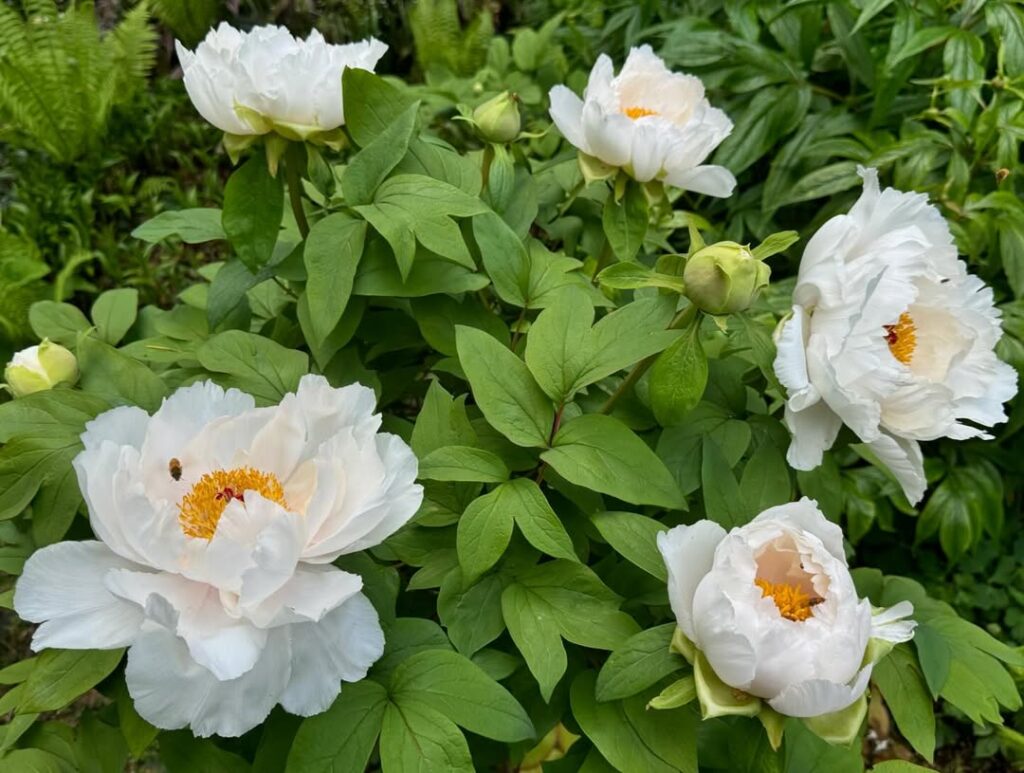
Western Trillium is a stunning native wildflower that brings elegant beauty to rain-loving Pacific Northwest gardens. This deciduous perennial produces distinctive three-petaled white flowers in early spring, rising above a whorl of three broad leaves on stems reaching 4-18 inches tall. Thriving in the moist, acidic conditions typical of Western Oregon’s forests, this woodland gem creates natural-looking displays in shaded garden areas.
Perfect for woodland and rain gardens, Western Trillium attracts beneficial pollinators like bumble bees while adding authentic Pacific Northwest character to shaded landscapes. Its preference for rich, organic soils and consistent moisture makes it an ideal choice for gardeners seeking to recreate the understory conditions of mature coastal forests. The petals undergo a beautiful color transformation from white to pink or purple as the flowers age, extending the visual interest throughout the blooming period.
- Hardiness: USDA zones 5-8, native to Pacific Northwest climate conditions
- Light: Full shade to part-sun, prefers filtered light conditions
- Water: Consistently moist to wet soil, requires regular moisture especially during growing season
- Soil: Rich, acidic, well-draining soil with high organic matter content
- Fertilizer: Benefits from natural leaf litter and organic matter, minimal fertilization needed
- Pest/Disease Resistance: Generally resistant when grown in appropriate native conditions
- Growth Rate: Slow to moderate, establishes gradually in suitable forest garden environments
Rain-Loving Canopy Trees
Western Oregon’s wet climate supports magnificent native canopy trees that thrive in high rainfall and saturated soils, forming the backbone of riparian forests and wetland ecosystems. The Red Alder particularly excels in these conditions, commonly establishing itself along stream banks where it can access consistent moisture year-round.
Douglas Fir (Pseudotsuga Menziesii)

The Douglas Fir is a magnificent evergreen conifer native to western North America, despite its common name, it’s not a true fir but belongs to its own genus, Pseudotsuga. This rain-loving giant can reach impressive heights of 40-80 feet in cultivation and over 300 feet in the wild, making it the tallest tree in the pine family. Distinguished by its flat, soft needles with white-green undersides and distinctive pendulous cones with three-pointed bracts, the Douglas Fir is one of the world’s most valuable timber trees.
Its thick, deeply furrowed bark makes it remarkably fire-resistant, while its preference for moist conditions makes it perfectly suited to western Oregon’s rainy climate. The tree’s sweet-scented resin and year-round evergreen foliage provide both ecological value and winter interest, though its eventual massive size makes it better suited for large landscapes rather than typical residential settings. When the needles are bruised, they release a fragrant aroma that adds to the tree’s appeal.
- Hardiness: USDA zones 4-6, intolerant to heat and humidity
- Light: Full sun
- Water: High moisture requirements, drought intolerant, needs consistent watering
- Soil: Acidic to neutral, moist, well-drained, organically rich soil
- Fertilizer: Minimal fertilizer needs in appropriate soil conditions
- Pest/Disease Resistance: Generally resistant with thick bark providing fire protection
- Growth Rate: Moderate to fast growth rate
Western Hemlock (Tsuga Heterophylla)
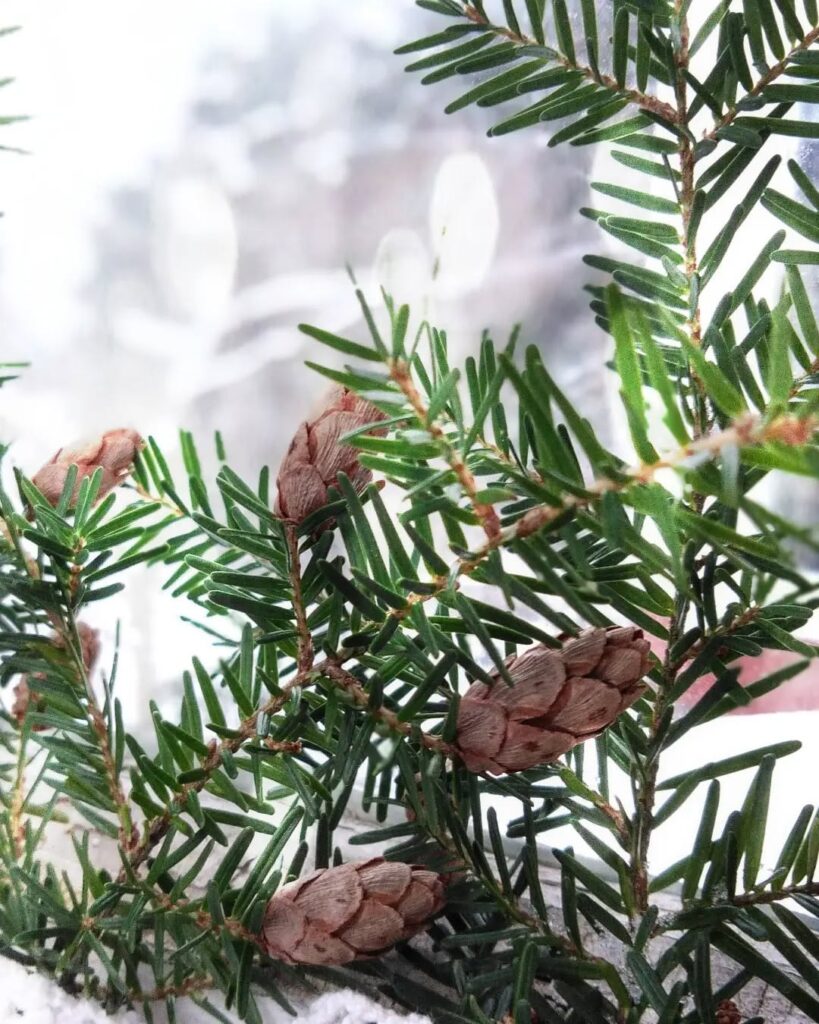
Western Hemlock is a majestic rain-loving conifer that serves as one of the Pacific Northwest’s most important canopy trees. This pyramidal evergreen features distinctive drooping branches with glossy dark green needles that have white undersides, creating beautiful visual contrast. Growing 60-100 feet tall with occasional specimens reaching 150 feet, it thrives in the cool, moist forests typical of western Oregon and has earned recognition as the “Cinderella of the Northwest” for its timber value.
As both a pioneer species and climax dominant, Western Hemlock plays a vital ecological role in Pacific Northwest forests. Its adaptability to humid coastal environments and contribution to multiple forest zones make it an essential component of the region’s ecosystem, providing important browse for wildlife while serving as a major timber species marketed as “Hem-Fir.” The species demonstrates remarkable germination abilities, with small seeds able to establish on nurse logs and decaying stumps where roots eventually extend down into the soil below.
- Hardiness: USDA zones 6-8, adapted to Pacific Northwest coastal climate
- Light: Partial shade to full sun, tolerates heavy shade when young
- Water: High moisture requirements, thrives in consistently moist conditions
- Soil: Well-draining, acidic soils; tolerates various soil types in humid environments
- Fertilizer: Low requirements in native forest settings with natural organic matter
- Pest/Disease Resistance: Generally resistant but can be affected by root rot in poorly drained soils
- Growth Rate: Moderate to fast growth in ideal cool, moist conditions
Western Red Cedar (Thuja)
Western Red Cedar is a magnificent evergreen native to the Pacific Northwest, thriving in the maritime climate from southern Alaska to northern California. This iconic conifer can reach towering heights of up to 60 meters with distinctive flattened sprays of scale-like foliage. Known for its exceptional tolerance of poorly drained soils and winter groundwater, it serves as a major canopy species in wet temperate forests.
As a rain-loving native, Western Red Cedar excels in moist habitats including shaded forests, swamps, and riverbanks. It reproduces through both seeds and vegetative methods like layering, with cone production beginning at 10-20 years. This species commonly grows alongside western hemlock, Sitka spruce, and Douglas-fir in mixed coniferous stands throughout western Oregon’s coastal and Cascade regions. The heartwood contains natural fungicides called thujaplicins that prevent the wood from rotting for approximately a century.
- Hardiness: USDA zones 6-8, vulnerable to temperatures below -30°C (-22°F)
- Light: Partial shade to full sun, tolerates shaded forest conditions
- Water: High water needs, thrives with consistent moisture and tolerates stagnant winter groundwater
- Soil: Prefers moist, acidic, well-drained soils but adapts to heavy clay and poorly drained conditions
- Fertilizer: Low requirements, adapted to nutrient-poor soils
- Pest/Disease Resistance: Generally resistant, relatively hardy compared to other conifers
- Growth Rate: Moderate to fast, reaching maturity over several decades
Big Leaf Maple (Acer)
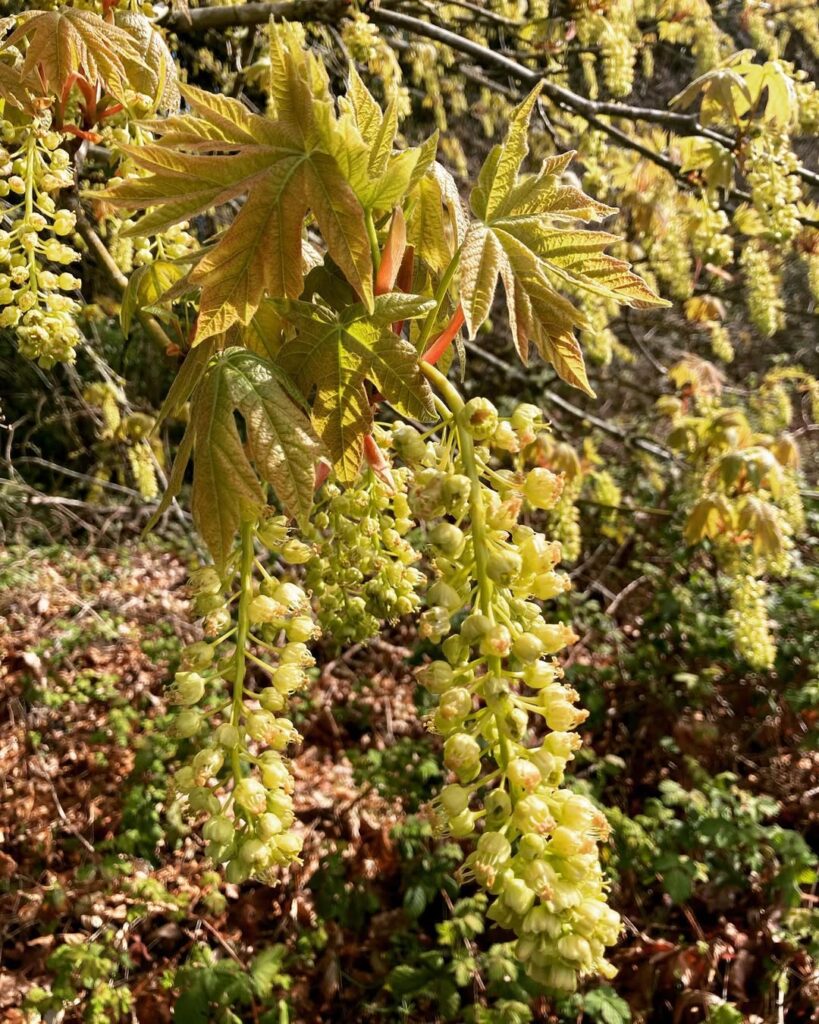
The Big Leaf Maple is a magnificent native tree that dominates the Pacific Northwest landscape with its impressive stature and distinctive foliage. Growing 50-100 feet tall with leaves that can reach up to 24 inches across—the largest of any maple species—this rain-loving giant thrives in western Oregon’s moist climate. It develops a broad, rounded crown in open areas and serves as a cornerstone species in mixed hardwood forests.
Beyond its striking appearance, the Big Leaf Maple provides exceptional ecological value while offering practical benefits to humans. Its dense canopy creates essential habitat for understory species, while early spring flowers support pollinators before conifers leaf out. The fine-grained wood is highly prized for furniture and musical instruments, often displaying beautiful figured patterns like birdseye and quilted grain that make it especially valuable to woodworkers. These remarkable trees can live for up to 300 years, making them truly enduring elements of the Pacific Northwest forest ecosystem.
- Hardiness: USDA zones 6-9, well-adapted to Pacific Northwest conditions
- Light: Full sun to partial shade, tolerates various light conditions
- Water: High moisture requirements, thrives with consistent rainfall and near water sources
- Soil: Moist, well-draining soils; tolerates various soil types from valley floors to rocky slopes
- Fertilizer: Generally not required in native forest soils with adequate organic matter
- Pest/Disease Resistance: Good overall resistance, may experience occasional fungal issues in overly wet conditions
- Growth Rate: Moderate to fast growth rate, especially in ideal moist conditions
Oregon White Oak (Quercus)

Oregon White Oak is a majestic native tree that can reach 50-100 feet tall with distinctive deeply furrowed gray bark and rounded-lobed leaves. These exceptionally long-lived trees (250-500 years) serve as biodiversity hotspots, providing critical habitat and acorns for wildlife including birds, mammals, and insects.
Despite being featured under “rain-loving” plants, Oregon White Oak actually demonstrates remarkable drought tolerance and fire resistance. It thrives in diverse conditions from moist flood plains to dry rocky slopes, making it incredibly adaptable to western Oregon’s varied landscapes and seasonal moisture patterns. Native peoples historically burned oak prairies to manage the growth of encroaching conifers.
- Hardiness: USDA zones 7-10; extremely hardy and long-lived
- Light: Full sun to partial shade; thrives in open woodland conditions
- Water: Drought tolerant once established; adapts to both dry uplands and moist flood plains
- Soil: Highly adaptable – tolerates deep loams, heavy clays, rocky sites, and various soil types
- Fertilizer: No fertilizer needed; thrives in native soil conditions
- Pest/Disease Resistance: Generally resistant; thick bark provides fire protection
- Growth Rate: Slow-growing but exceptionally long-lived (250-500 years)
Rain-Tolerant Understory Shrubs
Rain-tolerant understory shrubs provide essential habitat layers while thriving in western Oregon’s wet winters, offering diverse native species selections, ecological benefits, and practical maintenance considerations. These native shrubs require less water, naturally reducing rainwater runoff and preventing soil erosion throughout the region.
Oregon Grape (Mahonia Aquifolium)
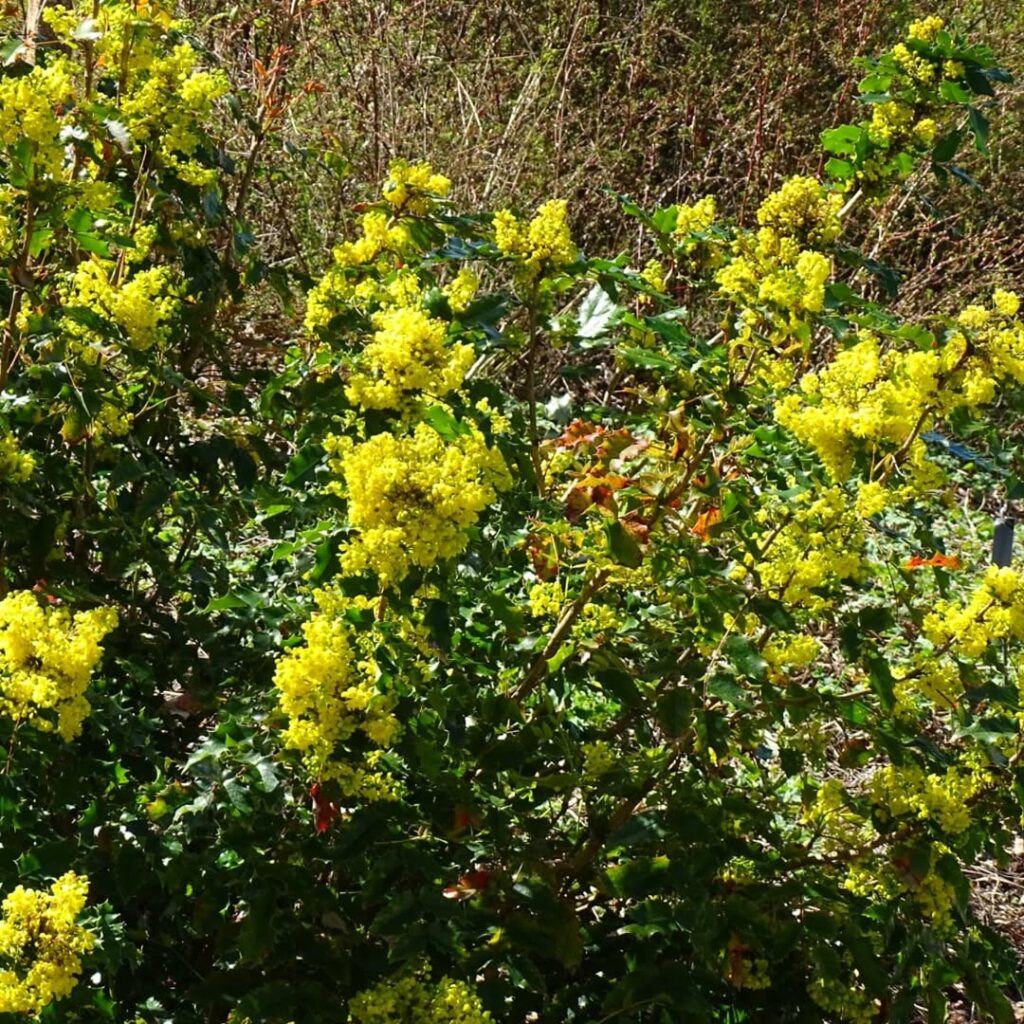
Oregon Grape is a versatile evergreen shrub that serves as an excellent rain-tolerant understory plant in western Oregon landscapes. Growing 3-8 feet tall with distinctive holly-like compound leaves, this native beauty offers year-round interest through its seasonal color changes—from bronze-red spring growth to dark green summer foliage that develops purplish tints in winter.
The shrub produces fragrant yellow bell-shaped flowers in early spring clusters, followed by dark blue berries that attract wildlife. Beyond its ornamental value, Oregon Grape holds special significance as Oregon’s state flower and provides edible berries for both humans and wildlife, making it an ideal choice for naturalistic gardens and woodland settings.
Oregon Grape’s spiny foliage provides additional security benefits, making it excellent for creating natural barriers while maintaining its decorative appeal.
- Hardiness: USDA Zone 5a to 9 (-20°F)
- Light: Full shade to full sun; thrives in partial shade
- Water: Moderate to high; drought tolerant once established
- Soil: Moist, well-draining; adaptable to various soil types
- Fertilizer: Low maintenance; minimal fertilization needed
- Pest/Disease Resistance: Generally resistant to most pests and diseases
- Growth Rate: Moderate; spreads via underground stems to form colonies
Salal (Gaultheria Shallon)
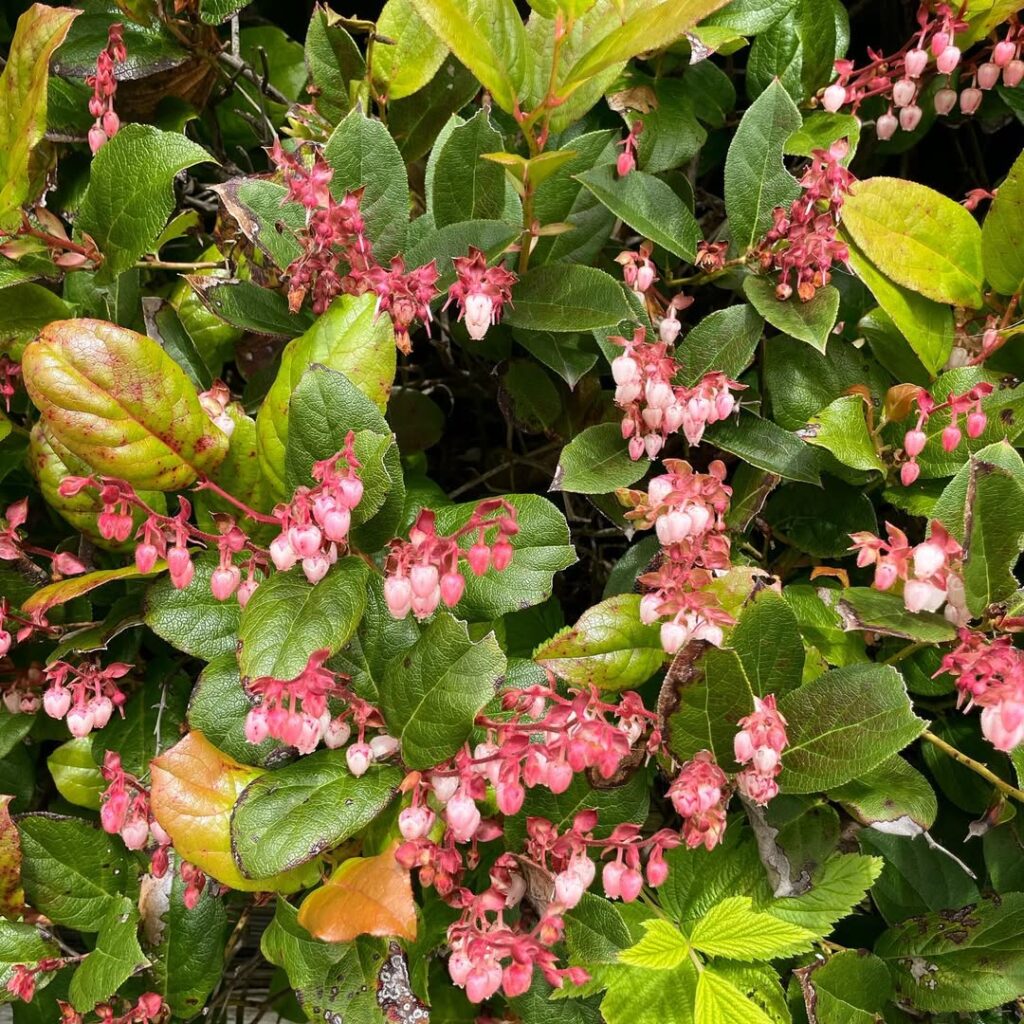
Salal is a versatile evergreen shrub native to western North America, thriving from Southeast Alaska to central California. This hardy understory plant produces glossy, leathery leaves and clusters of urn-shaped white to pinkish flowers followed by purple berries. Growing 1-5 feet tall, salal spreads extensively through rhizomes, forming dense thickets that provide essential wildlife habitat and food sources.
Well-adapted to the Pacific Northwest’s wet climate, salal excels in both coastal and inland forest ecosystems. Its leaves are highly valued in the floral industry, while Native peoples have traditionally used both berries and leaves. The plant’s ability to grow on decaying wood and tolerate salt spray makes it exceptional for habitat restoration and slope stabilization projects. What appear to be berries are actually fleshy sepals that surround the true fruit.
- Hardiness: USDA Zone 6-9
- Light: Partial shade to partial sun; tolerates moderate shade
- Water: Moderate to high; thrives in moist conditions and wet climates
- Soil: Moist sandy or peaty soils; adaptable to various soil types including decaying wood
- Fertilizer: Low maintenance; minimal fertilizer requirements
- Pest/Disease Resistance: Generally hardy with good natural resistance
- Growth Rate: Moderate; spreads extensively through rhizomes to form thickets
Vine Maple (Acer Circinatum)
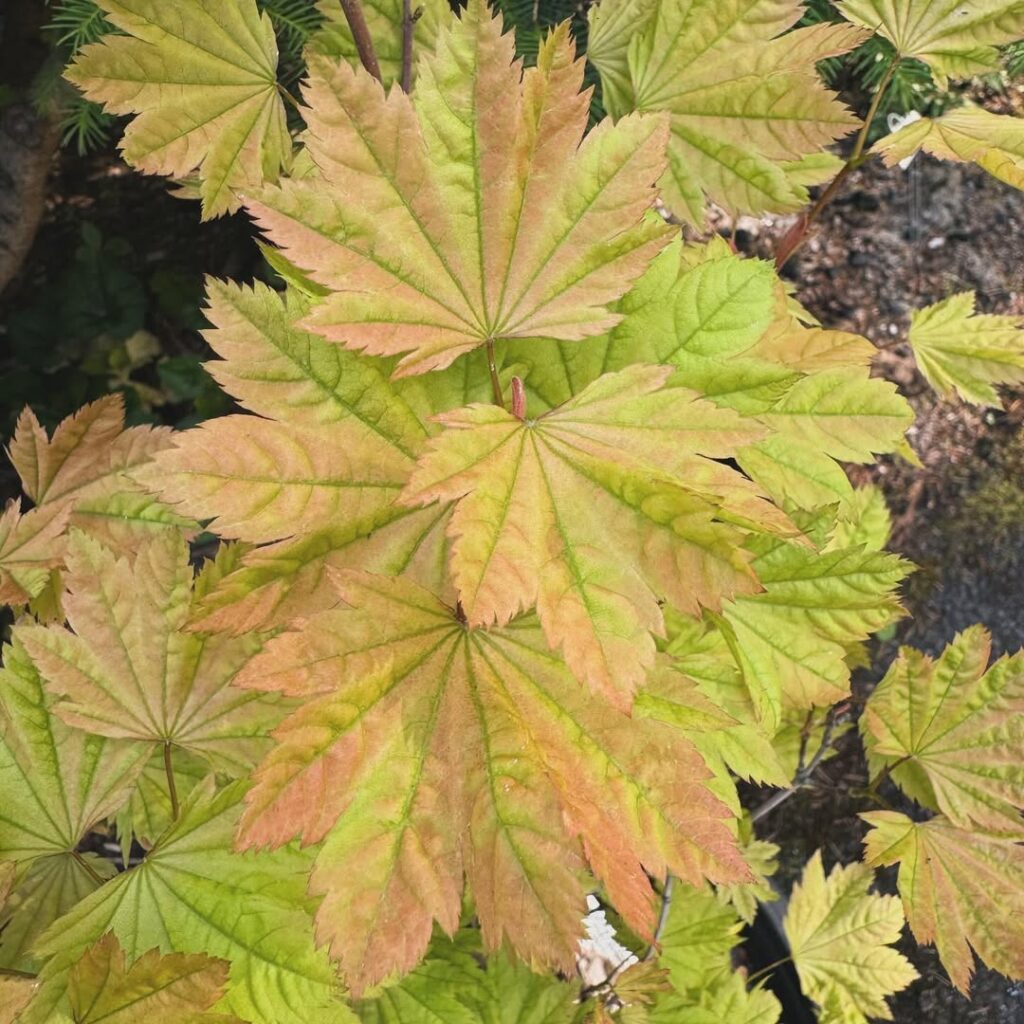
Vine maple is a graceful native shrub or small tree that thrives in the moist understory of western Oregon’s forests. Reaching 15-25 feet tall, it features distinctive palmate-lobed leaves that transform into brilliant reds, oranges, and yellows each autumn. This adaptable species naturally occurs from coastal rainforests to mid-elevation woodlands, where it forms dense thickets through vegetative layering.
As an important ecological component, vine maple provides critical wildlife habitat, nesting sites, and food sources while helping stabilize stream banks and forest soils. Its spring flowers attract native pollinators, and the plant supports various birds and mammals throughout the year. The plant produces distinctive winged fruits that turn deep red at maturity, adding ornamental interest beyond the spectacular fall foliage. Highly valued in restoration projects and native gardens, vine maple offers low-maintenance beauty with significant environmental benefits.
- Hardiness: Cold and heat tolerant, suitable for western Oregon climates up to 5,000 feet elevation
- Light: Part shade to full shade; can adapt to sunnier locations with adequate moisture
- Water: Medium water requirements; prefers consistently moist conditions but tolerates some dryness once established
- Soil: Thrives in moist, well-draining soils; excellent for stream banks and wet areas
- Fertilizer: Low maintenance; typically requires no supplemental fertilization
- Pest/Disease Resistance: Excellent resistance with few pest or disease issues
- Growth Rate: Moderate growth rate with vegetative propagation through layering
Pacific Ninebark (Physocarpus Capitatus)
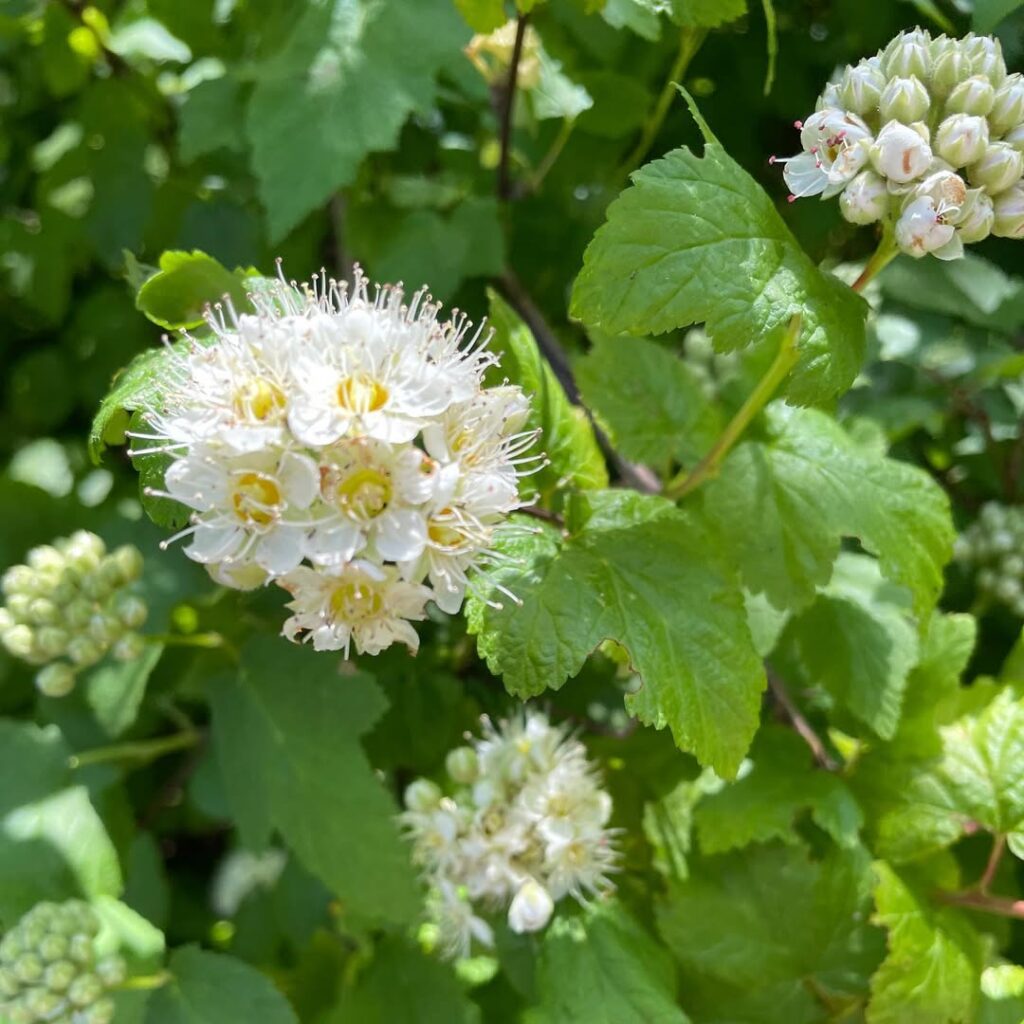
Pacific Ninebark (Physocarpus capitatus) is a versatile deciduous shrub native to western North America that thrives in Oregon’s moist environments. Growing 3-20 feet tall, it features distinctive reddish-brown exfoliating bark, palmately lobed leaves, and clusters of white flowers in late spring followed by colorful inflated seed pods. This fast-growing shrub excels in wetland restoration and rain gardens.
With its extensive root system, Pacific Ninebark provides excellent erosion control along stream banks and slopes while offering significant wildlife value. The flowers attract native pollinators, fruits feed birds and small mammals, and dense foliage provides nesting habitat. The shrub adapts well to various soil types with adequate moisture, including challenging serpentine soils. Its multi-seasonal interest and ability to tolerate both sun and shade make it an ideal choice for native landscapes and restoration projects.
- Hardiness: USDA zones 6-9, cold hardy to southern Alaska
- Light: Full sun to partial shade; tolerates deep shade with reduced flowering
- Water: High moisture requirements; thrives in consistently moist to wet soils
- Soil: Prefers acidic, well-draining soils; tolerates seasonally wet conditions
- Fertilizer: Low requirements; benefits from organic matter in poor soils
- Pest/Disease Resistance: Generally resistant with few serious pest or disease issues
- Growth Rate: Fast-growing, especially with adequate water and light
Evergreen Huckleberry (Vaccinium Ovatum)
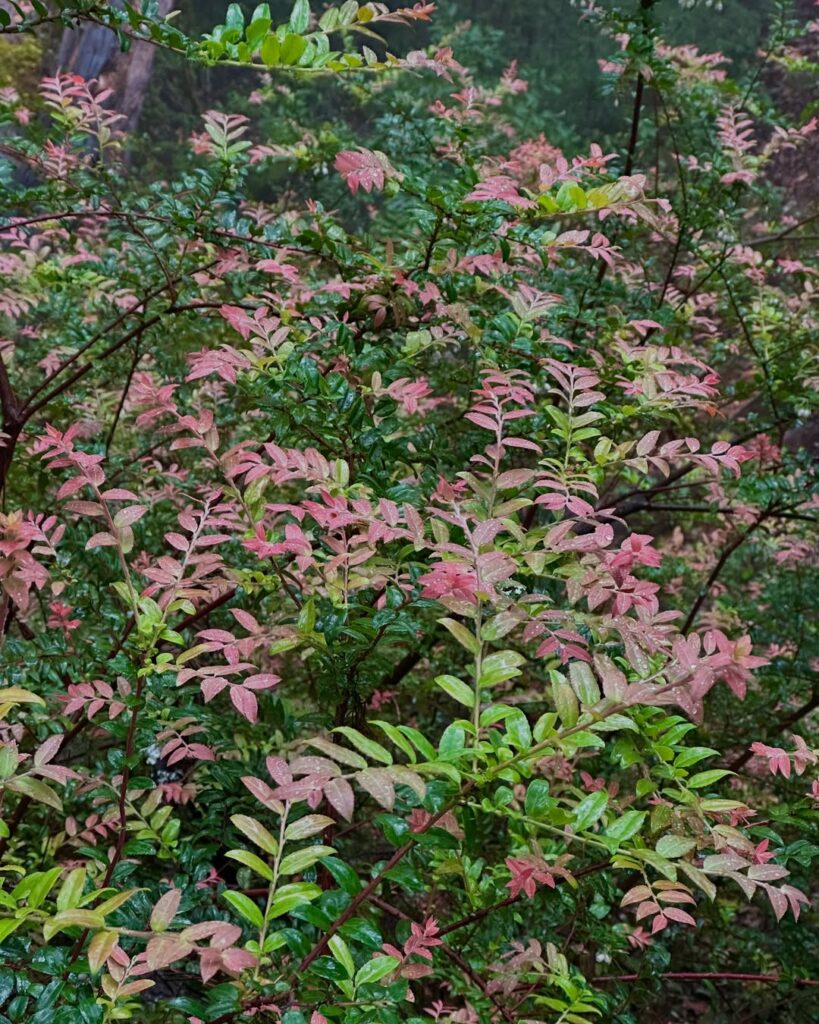
Evergreen huckleberry is a broadleaf evergreen shrub native to Pacific coastal regions from British Columbia to California. This compact, 3-5 foot tall understory plant features glossy, dark green leaves with toothed edges and attractive reddish stems. It produces pale pink, urn-shaped flowers in spring followed by edible berries that mature from red to blue-black.
Particularly well-suited to western Oregon’s wet climate, evergreen huckleberry thrives in the moist, acidic soils of coniferous forests. While slow-growing and challenging to propagate, once established it requires minimal maintenance and provides year-round habitat value. The berries are prized by wildlife and humans alike, and the attractive foliage makes it valuable for the florist industry. This species was introduced into cultivation by David Douglas in 1826, marking its significance in ornamental horticulture.
- Hardiness: Hardy in western Oregon’s climate zones, tolerates coastal salt spray and forest conditions
- Light: Partial shade preferred, tolerates full sun to full shade
- Water: High moisture tolerance, thrives in wet conditions, drought-resistant once established
- Soil: Moist, well-drained, acidic soils; adapts to slightly dry soils after establishment
- Fertilizer: Minimal requirements, thrives in natural forest soil conditions
- Pest/Disease Resistance: Excellent resistance to most pests and diseases
- Growth Rate: Slow-growing but long-lived
Selecting the Right Native Plants for Your Garden
When you’re choosing native plants for your western Oregon garden, success hinges on matching each species to your specific site conditions. Your soil drainage, sunlight exposure, and moisture levels determine which species will thrive. Rain-loving natives like red-twig dogwood excel in consistently moist areas, while others need excellent drainage.
Effective garden design requires layering trees, shrubs, and groundcovers for year-round interest. Group plants together based on their shared requirements for sun, shade, and drainage to create zoning that promotes healthier growth. Proper plant care starts with selecting locally sourced stock from reliable nurseries, avoiding wild transplants that disrupt ecosystems.
- Western maidenhair fern creating emerald cascades in shaded woodland corners
- Pacific ninebark’s white flower clusters brightening soggy streamside plantings
- Oregon iris painting purple strokes across spring meadow gardens
Frequently Asked Questions
When Is the Best Time to Plant Rain-Loving Natives in Western Oregon?
You’ll find the best planting season for native plant varieties runs from September through March. Plant during fall or early spring when natural rainfall helps establish roots before summer’s dry months arrive.
How Do I Prepare Soil Drainage for Rain-Loving Native Plants?
You’ll want to skip soil amendments for rain-loving natives since they prefer natural conditions. Focus on drainage solutions like creating shallow depressions, adding organic matter, and ensuring proper water flow patterns.
What Are Common Pests That Affect Rain-Loving Natives in This Region?
Slugs and snails cause 60% of Pacific Northwest plant damage. You’ll need proper pest identification since aphids, spider mites, and caterpillar infestations also threaten your rain-loving natives. Effective pest management involves attracting beneficial insects naturally.
How Much Maintenance Do Established Rain-Loving Native Plants Require Annually?
You’ll find annual care for established rain-loving natives is minimal. Basic maintenance tips include watering once or twice monthly during summer drought and allowing dormant plants to rest naturally without intervention.
Can Rain-Loving Natives Survive Western Oregon’s Occasional Summer Drought Periods?
You’ll find that established rain-loving natives develop impressive drought resilience through deep root systems and natural adaptations. With proper site selection emphasizing moisture retention, they’ll survive Western Oregon’s occasional summer dry spells without supplemental watering.
